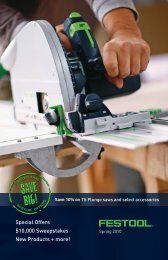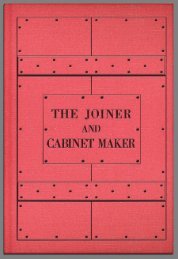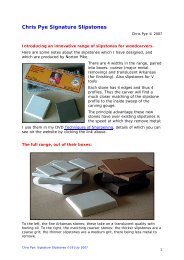Download Vol.2 - No. 55 - Tools for Working Wood
Download Vol.2 - No. 55 - Tools for Working Wood
Download Vol.2 - No. 55 - Tools for Working Wood
Create successful ePaper yourself
Turn your PDF publications into a flip-book with our unique Google optimized e-Paper software.
_<br />
...<br />
CLEANING AND LACQUER iVG OPTICAL BRASSIVORK. [Work-April 5, 1890.<br />
•<br />
object to the fumes of the nitric acid may<br />
n c;e the followin~ , pickle, which has no ~m <br />
pleasant smell : oo.ake a. saturated solutiOn<br />
of bichromate of potash with boiling water,<br />
and (when cold) add I oz. of sulplmric acid<br />
slowly to every { pi~t of solution. N e\·er _add<br />
the water to t he ac1d or pour the latter mto<br />
the hot solution, as it m1ght be attended by<br />
senous consequences.<br />
•<br />
If an article has to be handled after<br />
dipping or polishing, it should be held in<br />
rag in the hand, or suspended on a piece of<br />
' vire bent in t he <strong>for</strong>m of o. hook, or it mar<br />
be held between a pair of tweezers, a strip<br />
of wood slit longitudinally being a capital<br />
substitute <strong>for</strong> the latter. A brass or copper<br />
wire of about <strong>No</strong>. 10 B.W.G. may be hent<br />
into the <strong>for</strong>m of a hook similar to Fig. l ,<br />
and used <strong>for</strong> the ~urpose of hn.nging the<br />
articles on while chppmg, flat brass plates<br />
being placed on a wire holder similar to<br />
Fig. 2. As stated above, it is n eces~n.ry to<br />
avoid handling the work during t he operation<br />
of dipping, etc., as the slightest trace<br />
of grease from the fingers will spoil the<br />
after process of lacquering.<br />
In preparing new microscope fittings <strong>for</strong><br />
la~quering-or in fact, any work <strong>for</strong> whil' h<br />
a superior finish is required-it will be necessary<br />
to first scrape up the cun·ed ed!!es of<br />
the various part~, holding them in the ' hand.<br />
or clamping them in the jaws of a Yiee<br />
between two pieces of sheet lead or leather.<br />
The tool employed .<strong>for</strong> this purpose will be<br />
n. scraper, which is simply n.n ordinary triangular<br />
file, the sides of which have been<br />
ground up smooth and sharp on a grinllstone,<br />
the edges being set on an oilstone<br />
until they are sufficiently sharp to take off<br />
clean bri~ht shavings. All the flat surfaces<br />
and stra1ght edges of the work mm;t he<br />
smoothed by means of a dead smooth file.<br />
which will obliterate all traces of the previous<br />
file-marks. When this has been done,<br />
take a piece of emery paper (not cloth) and<br />
use this to get rid of the file marks, wrapping<br />
it round an old smooth flat file or a thin<br />
strip of wood, having previously cut the<br />
paper to a size about an inch less in length<br />
and about three times the width of the tile<br />
or wood, in order that it may be wrapped<br />
round it and held in position by the <strong>for</strong>efinger<br />
of the right hand whilst in use. bein~<br />
partioular to rub iu one direction only, and<br />
continue the process until all t.-a.ces of the<br />
file marks have disappeared, when a fi11er<br />
emery paper may be substituted, until the<br />
finest (or flour) emery is finally usecl to<br />
obliterate the marks made by the previous<br />
paper. If a drop of oil is now smeared OYer<br />
the surface of the brass the gmin may he<br />
brou~ht up to a smooth and even semipolisll.<br />
It will be necessary to carefully<br />
clear away all traces of emery dust be<strong>for</strong>e<br />
commencing to use a finer paper, otherwise<br />
ugly scratches will continually appear on the<br />
surfac~ of the work, only to be eradicated<br />
by gomg back a step and commencing de<br />
novo. After the finest paper the fi nish will<br />
be very good, but it can be further improved<br />
by rubbing with a piece of water-of<br />
Ayr stone, which must be moistened with<br />
water from time to time.<br />
Never S).lbstitute emery cloth <strong>for</strong> the<br />
paper, as the latter lasts much longer and<br />
works smoot~er than the <strong>for</strong>mer, very frequently<br />
·workmg down to a glossy surface<br />
be<strong>for</strong>e aiving way, and, moreover, the flatness<br />
n.nd sharp edges of the work arc better<br />
preserved . by t?e paper th~n by the cloth.<br />
If the art1cle 1~ now held m a clean rag in<br />
the hand, and 1s then brushed with a soft<br />
br~sh (or a. stick covered with one or two<br />
tthlclroasses oLwoollen cloth) and a little<br />
whiting, being afterwards wiped dry on a<br />
clean linen rag, it will then be ready <strong>for</strong><br />
lacquering : or, if desired. the final poli,-h<br />
mar be imparted by means of a buff :::tick<br />
and a little crocus powder, or any of the<br />
nnmerou ::; polishing pastes and powders.<br />
or the latter, the writer has personally used<br />
"Dos is':-; l\letal Polish," -?!d. per packet, and<br />
the " U ni\'ersal Metal Polishing Pomade,"<br />
1 d. per tin. The latter, which is a German<br />
preparation. has gnined four yrize medal:;,<br />
including a gold medal at Kensington in<br />
I SS-l. and it is certainly the most useful<br />
article <strong>for</strong> instantly imparting n brilliant<br />
polish to metal work that the writer has<br />
ever had the pleasure of using. :\Ir. H.<br />
Seegcr, :21, .Mincing Lane, London, E.C., is<br />
the :-;ole agent <strong>for</strong> Great Britain, but it can<br />
be obtained from oilmen and some cyclist<br />
cm port u ms.<br />
•<br />
The fl)llowing 'nil be found the be::;t<br />
md boJ of u,;ing the preparation : Anoint a<br />
~====0<br />
I'.ig. ~ .<br />
~====n<br />
l'ig . .z.<br />
1' ig 3 .<br />
I'ig.i:<br />
J:jg. 5<br />
Fig. 1.- Wire Book <strong>for</strong> Handling Articles a fter<br />
Dipping or Polishing. Fig. 2.-Wire Bolder<br />
<strong>for</strong> Dipping. Fig. 3.-Mode o! Chamfering<br />
End of Stone. Fig. 4.-Mode of M aking Bu1f.<br />
Fig. 5.- Best <strong>for</strong>m o! Brush !or Lacquering<br />
Broad Surfaces.<br />
polishing buff with a little-not much-and<br />
then rub briskly, and with considerable<br />
pressure, upon the surfn.ce to be I)Olished,<br />
remembering thn.t it is al·ways usua to take<br />
t he strokes off lengthwise of the work,<br />
which should be the same way as the grain<br />
left by th~ emery papering. This will<br />
speedily bring up the surface to a lustrous<br />
polish, proYiding that the article has pre<br />
Yiously been papered up smooth{ and care<br />
has been taken to eradica.te a I the file<br />
marks. When the superfluous pomade has<br />
been cleared off by means of a piece of soft<br />
rag, the surface will present a polish very<br />
slightly inferior to a burnish in point of<br />
brilliancy. The screw holes will require<br />
cleaning out with a piece of pointed wood<br />
cut to the requisite size. This is a necessary<br />
precaution, otherwise the grease will<br />
melt out of the holes when the article is<br />
heated and overrun the surface, thus spoiling<br />
the la.c













